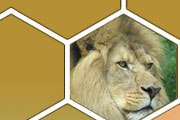

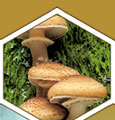
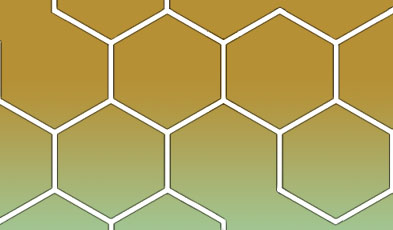
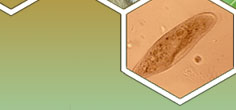
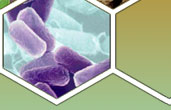
   |
 |
  |
|
Descriptions |
Genera |
|
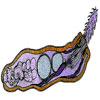 |
Acanthocephala
(thorny-headed worms) Campbell p.640 They feed as parasites living in the gut of vertebrates and - earlier in their life cycle - within invertebrates. Adult females are larger in size at about 2 cm in length; the longest is more than 1 meter and some are as short as 1 mm. They are found worldwide in soil, fresh water, or salt seas. |
Acanthogyrus Moniliformis Plagiorhynchus |
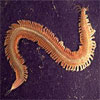 |
Annelida
(annelid worms) Campbell p.640, 653-55 They are distinguished by their linear series of external ringlike segments; the grooves between segments coincide with internal compartments, often separated by transverse sheets of tissue (septa), containing serially repeated nervous, muscle, and excretory systems. Annelids live in soil, fresh water, and oceans- including Antarctic seas. |
Aphrodite Lamellisabella Nephthys Zenkevitchiana |
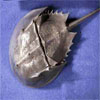 |
Arthropoda
Campbell p.641, 656-65 Other subphyla includes Chelicerata, Mandibulata, and Crustacea. They have segmented bodies, jointed appendages, and a chitinous exoskeleton in common with other arthropods. There are more than one million arthropod species and about a billion billion (10^18) individuals inhabiting nearly everywhere of the biosphere. |
Arachnida Malacostraca Nymphon |
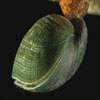 |
Brachiopoda
(lampshells, brachiopods) Campbell p.640, 649 They are called lampshells because they resemble ancient oil lamps. Like clams and other bivalve molluscs, the brachiopod has two apposed hard shells. They mostly occupy marine habitats between the intertidal zone of the beach and 4000 meters deep. |
Argyrotheca Lingula Terebratula |
 |
Chaetognatha
(arrow worms) Their name arrow worm is given due to their arrow-shaped bodies. They prey by detecting vibrations. Arrow worms are common plankton worldwide expecially abundant in warm seas to a depth of about 200 meters. |
Bathybelos Krohnitta Pterosagitta |
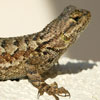 |
Chordata
Campbell p.641, 671 Other subphyla includes Cephalochordata, Urochordata, and Vertebrata. They are bilaterally symmetrical animals with distinctive morphological features such as the notochord, nerve cord, pharyngeal slits, and post-anal tail. More than 90% of all chordate species have backbones, the ones without are divided into three groups: tunicates, lancelets, and hagfishes. |
Balaenoptera Epigonichthys Pyrosoma |
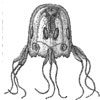 |
Cnidaria
(nidarians, hydras) Campbell p.526, 639, 643 All cnidarians are aquatic and nearly all are marine. They are radially symmetrical invertebrates having two basic body patterns, polyp and medusa. Some cnidarian species are exclusively polyps; others are medusae only' and still others alternate between polyp and medusa forms. |
Antipathes Dendronephthya Obelia |
 |
Ctenophora
(comb jellies) Campbell p.640 Ctenophoran bodies are flexible and mobile, the consistency of soft jelly in a membrane bag. They range in size from 0.4 cm to more than 1 m in length. Paddlelike comb plates (ctenes) unique to ctenophorans sweep these translucent, biradially symmetrical invertebrates through the sea. |
Cestum Mnemiopsis Thalassocalyce |
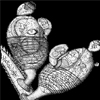 |
Cycliophora
Campbell p. 641 The only specie in this phylum, Symbion pandora, was first discovered on the mouthparts of a lobster. They are complete with a digestive tract. They have complex life cycles involving different stages as sessile or free-swimming organisms. |
Symbion |
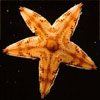 |
Echinodermata
(echinoderms, sea stars) Campbell p.641, 665-67 The adults are radially symmetrical invertebrates with three unique features: five part symmetery; an internal calcium carbonate skeleton: and a distinctively divided coelom, including a water vascular system. Most of the 7000 living echinoderm species are intertidal or subtidal. All are marine, mostly members of shallow-water biota. |
Bathycrinus Pisaster Thyone |
 |
Echiura
(spoon-worms, echiurans, echiurids) They are known for their flexible proboscises, which may extend as far as 1.5 meter from their plump, soft trunks. Their cylindrical or ovoid bodies may be dull brown, gray, red, rose, yellow, or transparent. Echiurans dwell in U-shaped tunnels, mud, or rock crevices in estuaries, among mangrove roots, and in all oceans, some at depths of 10,000 meters in the abyss, none is found in fresh water. |
Bonellia Metabonellia Thalassema |
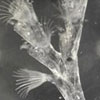 |
Ectoprocta
(Ectoprocts, bryozoans) Campbell p.639 They resemble moss animals, hence the given name bryozoans. They feed by creating a current with their tentacle cilia towards their mouth. Ectoprocta dwell as sessile colonies found in marine and freshwater. |
|
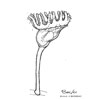 |
Entoprocta
(Entoprocts) Entoprocts are tiny, transparent animals, primarily marine. Most are sessile, living in colonies permanently and firmly attached by stalks, horizontal stolons, and basal discs to rocks, pilings, shells, algae, or other animals. They are widely distributed along seacoasts of Africa, South and North America, Asia, Europe, and the Arctic. |
Barentsia Loxosomella Pedicellina |
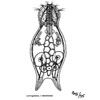 |
Gastrotricha
(gastrotrichs) Bristles, spines, or scales ornament the backs and sides of gastrotrichs leaving their bellies covered with cilia. Their flat, transparent body with lobed head ranges from less than 0.1 to 3.5 mm in length. Sandy beach crevices and aquatic environments are gastrotrich habitats. |
Dactylopodola Macrodasys Turbanella |
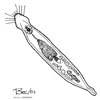 |
Gnathostomulida
(jaw worms) They have translucent bilaterally symmetrical bodies with toothed jaws near their ventral mouths. Jaw worms feed on fungi, bacteria, and protoctists among grains of sea sand. They can be found in shallow oceans down to a depth of several hundred meters throughout the world. |
Gnathostomula Nanognathia Pterognathia |
 |
Hemichordata
(acorn worms, enteroptneusts) Campbell p.641 Hemichordates are small, soft-bodied coelomates characterized by a proboscis, collar, and trunk with gill slits. Some live sedentary lives in the deep ocean; none are planktonic. |
Atubaria Glossobalanus Rhabdopleura |
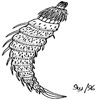 |
Kinorhyncha
(kinorhynchs) Campbell p.639 Kinorhynchs do not swim, but instead they force body fluid into its head and thereby everting, anchoring with scalids - spines - on its head in sand grains or mud and then hauling itself forward as it retracts its head. They have been collected all over the world on seafloors, in estuaries, and on muddy marine beaches. |
Campyloderes Kinorhynchus Semnoderes |
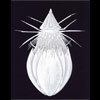 |
Loricifera
(loriciferans) Campbell p.640 A loriciferan is a microscopic marine animal with a mouth cone - a flexible anterior mouth tube - a head carrying club-shaped and clawlike spines, a neck (thorax), and a girdle of plates called a lorica that covers the abdomen. They have been found in shelly gravel dredged near the Atlantic shore in North Carolina and Florida, Arctic Ocean, and in the Coral Sea. What loriciferans eat is still unknown. |
Nanaloricus Pliciloricus Rugiloricus |
 |
Mollusca
(molluscs) Campbell p.640, 650-53 Most molluscs have an internal or an external shell, a muscular foot, and an unsegmented, soft body. They can be found in mud and sand flats, forests, soil, fresh water, deserts, driftwood, and the abyss of the sea. About 50,000 species of molluscs have been described. |
Busycon Dentalium Mercenaria |
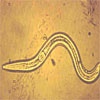 |
Nematoda
(nematodes, thread worms, roundworms) Campbell p.641, 655 Nematodes are unsegmented pseudocoelomate worms inconspicuous until they capture our attention by infesting us, our plants, or our animals. They lack circular muscles and so cannot extend and contract as segmented (annelid) worms do. They inhabit moist soils, beach sand, salt flats, the ocean, hot springs, and lake water in prodigious numbers. |
Ascaris Necator Trichodorus |
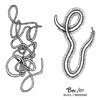 |
Nematomorpha
(gordian worms, horsehair worms, nematomorphs) They are free living in fresh or salt water. They live as endoparasites in a range of hosts such as leeches, beetles, cockroaches, but are rarely found in humans. Nematomorphs are leathery, unsegmented invertebrates - stiff as wire - and generally brown, black, gray, or yellowish in color. |
Chordodes Nectonema Paragordius |
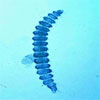 |
Nemertea
(ribbon worms, Proboscis worms) Campbell p.640, 649-50 Nemertea is a phylum consisting mostly of free-living worms found in marine, freshwater, and soil habitats. Their common name ribbon worm refers to their flat bodies and the brillant color of patterns. Nemerteans can be less than 1 mm to several meters. |
Amphiporus Gononemertes Nectonemertes |
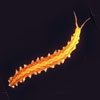 |
Onychophora
(velvet worms, onychophorans, peripatuses) Campbell p.641 They are known as velvet worms due to their cuticles that are studded with minute bumps that feel like velvet. Their bodies may be iridescent green, blue black, orange, red, or whitish, although most are brown. Velvet worms are terrestrial residing in high-humidity habitats such as forest litter, the underside of logs and rocks. |
Cephalofovea Peripatoides Speleoperipatus |
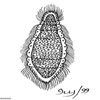 |
Orthonectida
(orthonectids) The adult wormlike body consists of as many as 40 rings of jacket cells and are ciliated. All are endoparasites of invertebrates and found throughout the world. |
Ciliocincta Rhopalura Stoecharthrum |
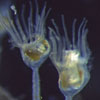 |
Phoronida
(phoronids) Campbell p.639, 649 All phoronids are sedentary marine worms, rare in most locales but found throughout the world. The phoronid bears a spirally coiled or horseshoe-shaped ridge with ciliated tentacles around its mouth. They feed by filtering on plankton and detritus and absorb dissolved organic compounds. |
Phoronis Phoronopsis |
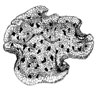 |
Placozoa
(trichoplaxes) Campbell p.639 The only specie in this phylum, Trichoplax adhaerens, is small and among the least complex of animals from 0.6 µm to 1.0 µm in length, similar to the size of a bacterium. These organisms are motile and their entire surface is ciliated. They reproduce by division or by budding off multicellular individiuals. |
Trichoplax |
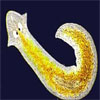 |
Platyhelminthes
(flatworms) Campbell p.639, 646 They are ribbon and leaf-shaped with bilaterally symmetrical soft bodies. Flatworms are masters of adaptation, exploiting an enormous variety of habitats from minus 50 to plus 47 degrees. |
Convoluta Fasciola Schistosoma |
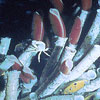 |
Pogonophora
(beard worms, pogonophorans, tube worms) This is the only phylum of free-living multicellular animals in which all lack digestive tracts as adults. The forepart includes a cephalid lobe containing the brain and bearing the beardlike tentacles that give the phylum its name. They feed by absorbing nutrient through the tentacles with the help of symbiotic bacteria. Found in cold, deep ocean waters as well as hot submarine vents. |
Lamellisabella Siboglinum Zenkevitchiana |
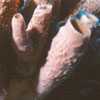 |
Porifera
(sponges, poriferans) Campbell p. 526, 639, 642, 853, 903 Sponges have no tissues or organs, lack anterior-posterior and any form of symmetry. Food is filtered from the copious quantities of water that flow through the sponge body. When a fragment breaks off, it may regenerate and grow to be individual sponges. |
Euplectella Leucosolenia Spongilla |
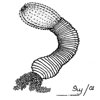 |
Priapulida
(priapulids) Campbell p.640 Priapulid worms have been collected from a variety of depths in the sea - from waters as shallow as intertidal pools and as deep as the ocean abyss. Their trunk consists of 30 to 100 superficial rings (bands of circular body wall muscle) covered with spines and warts. |
Halicryptus Meiopriapulus Tubiluchus |
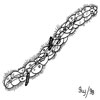 |
Rhombozoa
(rhombozoans) Rhombozoans are small wormlike, bilaterally symmetrical animals. They lack a body cavity and circulatory, respiratory, skeletal, muscular, nervous, excretory, and digestive systems. All are parasites and live in the bodies of benthic cephalopods mainly in temperate waters. |
Conocyema Dicyemennea Microcyema |
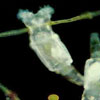 |
Rotifera
(rotifers) Campbell p.639, 648-49 The rotifer has waves of beating cilia on its head that appear to be a rotating whell. Rotifer shapes range from trumpetlike to spherical. They can be found in freshwater environments and in moist soil. |
Asplanchna Notommata Stephanoceros |
 |
Sipuncula
(sipunculans, sipunculids, peanut worms) Their distribution is patchy, tending to greatest abundance on rocky shores. Some feed on detritus in mud; others, on diatoms, other protoctists, and larvae. They are unsegmented with spines or papillae stud the distal part of the introvert in some species, some resemble ver firm peanuts. |
Aspidosiphon Phascolopsis Sipunculus |
 |
Tardigrada
(water bears, tardigrades) Campbell p.641 Their colors depend in part on their food. Tardigrades walk on four pairs of non joined, stumpy legs, each having moveable claws, pegs, or adhesive disks. The head and four body segments of the tardigrade are generally covered with chitinous cuticle. All water bears are aquatic. Most live in water films on moss, liverworts, lichens - habitats that take up water. |
Coronarctus Hypsibius Tetrakentron |